There are three main systems of Elvish tengwar writing. The first system is used for writing in the language Quenya. The second is for writing in Sindarin, and the third is for writing English. This third system, English, can be seen on the title pages of The Lord of the Rings and The Silmarillion. Below I will have the alphabet charts of the three writing systems as well as a few guidelines regarding usage of certain letters and such (all pictures are linked to their full size versions). However, I'd first like to note that the information and the charts on this page were taken from this page. All that is different is that I cleaned up the charts a bit (they were bit-a-lized) - Callista
Quenya Tengwar | Sindarin Tengwar | English Tengwar
Tengwar Charts for Quenya
Quenya Consonants
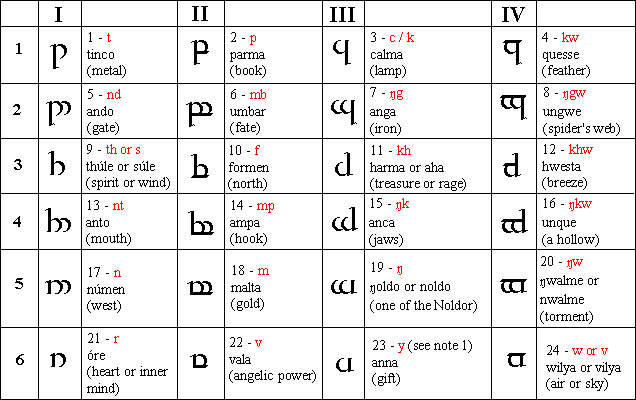
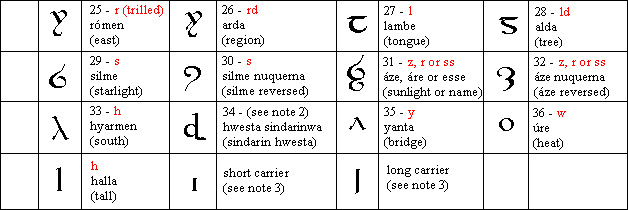
Note:
*1) Technically, anna does not have the value y when used in the Quenya mode; y is represented by anna + "following-y" tehta.  Anna is not used by itself in the published Quenya texts. Anna is not used by itself in the published Quenya texts.
**2) Although this letter is part of the standard set of additional letters, it is not used for writing Quenya language texts.
***3) The long and short carriers are silent letters. They are used in conjunction with vowel symbols.
Quenya Vowels
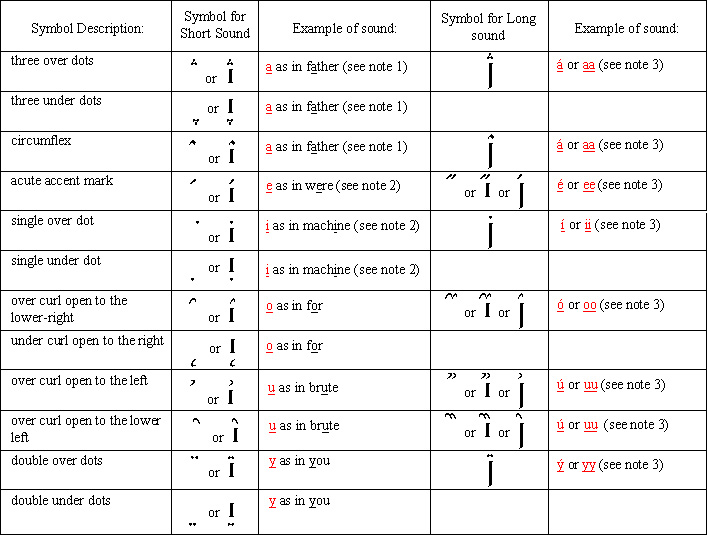
Note:
1) In Quenya, the a sound occurs so frequently, that it's symbol (three dots) is often simplified (to look like a circumflex) or if no confusion would occur, eliminated altogether.
2) All of the published Quenya Tengwar inscriptions by Tolkien have used the acute accent mark for the e sound and the single dot for the i sound, but Tolkien also stated that the reverse could be equally valid.
3) Long vowels have the same sound as short vowels, the only difference is the duration of the sound. For example: the short u is as the u in brute, while the long u is as the uu in cool (English pronunciation).
Writing Quenya with Tengwar
Writing Quenya with Tengwar is relativity easy, just remember that Tengwar is a phonetic alphabet. Words are written exactly as they are spoken. Typically the Tengwar (consonant letters) are written first, then the Tehtar (vowel symbols) are written above the
appropriate consonant. In Quenya, and other languages that end most words with vowels, the Tehta is placed above the previous Tengwar letter. To read Quenya/Tengwar script you would read each Tengwar letter, then the Tehtar vowel symbol above it (in an
upward motion), before going on to the next Tengwar/Tehtar letter combination.
For example:

If a word starts with a vowel sound (and there is no previous consonant letter in the word) then a "Carrier" symbol can be used. Carrier symbols do not represent a sound, but rather provide a symbol for vowel marks to be placed upon. There are two different
standard Carrier symbols; the "Short Carrier" and the "Long Carrier". The Short Carrier looks like the undotted letter "i". The Long Carrier looks like the undotted letter "j". The Long Carrier is used with "long" vowel sounds. If two or more vowel sounds appear
consecutively in a word, the Carrier symbol should be used when there is no consonant in the appropriate location.
For example:

Normally, "short" vowels are represented by a single Tehtar symbol above a Tengwar or Carrier symbol. But "long" vowels can be represented several different ways; long vowels can be written as two Tehtar above a single Tengwa, two Tehtar above a single
Short Carrier symbol, two Tehtar above two Short Carrier symbols, or one Tehta above a single Long Carrier symbol (preferred); as shown below:

The Quenya phrase Elen síla lúmenn' omentielvo", "A star shines on the hour of our meeting", could be transcribed:

Tengwar Charts for Sindarin
Sindarin Consonants
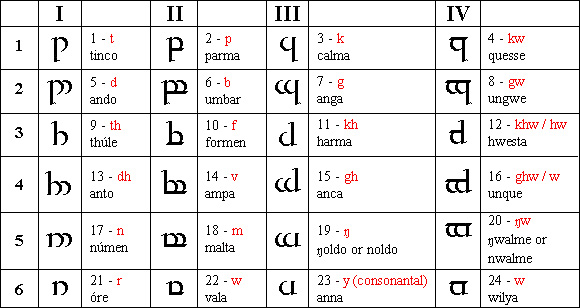

Note:
1) The long and short carriers are silent letters. They are used in conjunction with vowel symbols.
Sindarin Vowels

Note:
1) In Sindarin, the a sound occurs so frequently, that it's symbol (three dots) is often simplified (to look like a circumflex) or if no confusion would occur, eliminated altogether.
2) All of the published Sindarin Tengwar inscriptions by Tolkien (that use this mode) have used the acute accent mark for the e sound and the single dot for the i sound, but Tolkien also stated that the reverse could be equally valid.
3) Long vowels have the same sound as short vowels, the only difference is the duration of the sound. For example: the short u is as the u in brute, while the long u is as the uu in cool (English pronunciation).
Writing Sindarin with Tengwar (Standard Mode)
There are two ways to write Sindarin with the Tengwar letters, the Standard Mode and the Mode of Beleriand. At first glance the Standard Mode looks similar to the Quenya usage of Tengwar. But although the Sindarin and Quenya languages are related to each other, they often use different Tengwar letters to represent the same sounds. Also, in Sindarin and other languages that end most words with consonants, the Tehtar are placed above the next consecutive Tengwar letter. (Unlike Quenya where vowels are places above the previous Tengwar letter.) To read Sindarin/Tengwar script you would read each Tehtar vowel symbol, then the Tengwar letter below it (in a downward motion), before going on to the next Tehtar/Tengwar letter combination. For example:
Written in the style of Quenya (vowel over the previous consonant):

Written in the style of Sindarin Standard Mode (vowel over the next consonant):

Other than placement of Tehtar, and the different Tengwar phonetic value, this mode follows all of the same rules as Quenya. For example the Sindarin Inscription on the West Gate of Moria:
first line:

second line:

Could be transcribed (using the Sindarin Standard Mode for writing):
first line:

second line:

Tengwar Charts for English
Consonants
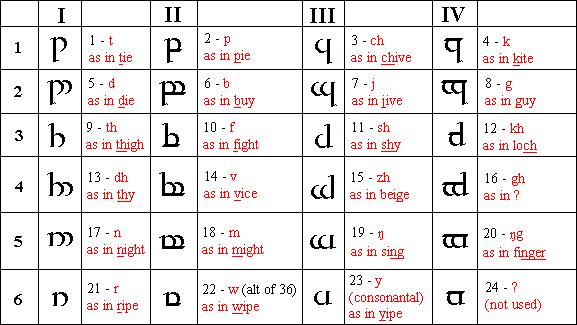

Note:
1) The long and short carriers are silent letters. They are used in conjunction with vowel symbols.
Vowels
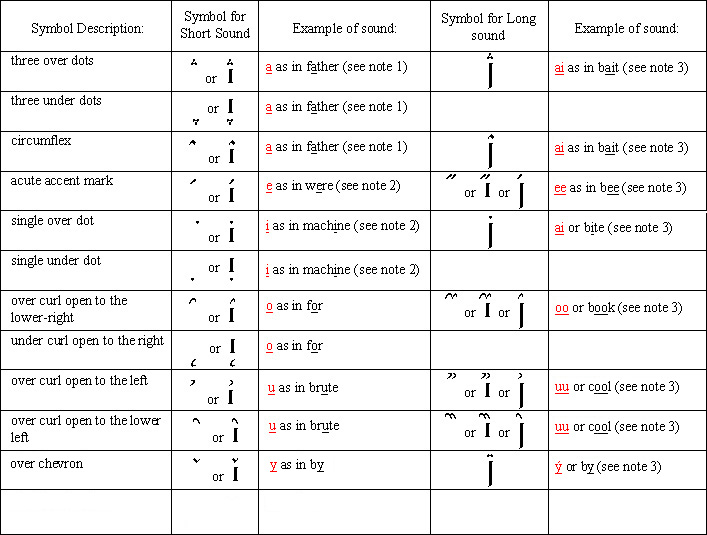
Note:
1) In "The Lord of the Rings" title page inscription, three dots are consistently uses to represent the a sound. But in Appendix E of "The Lord of the Rings", Tolkien states that the circumflex symbol can also be used to represent the a sound.
2) In "The Lord of the Rings" title page inscription, J.R.R. Tolkien used the acute accent mark for the e sound and the single over-dot for the i sound. But in the "Silmarillion" title page inscription, Christopher Tolkien consistently used the reverse (acute accent mark for the i sound and the single over-dot for the e sound). The Tehtar values in this chart correspond to J.R.R. Tolkien's "The Lord of the Rings" title page inscription.
3) Long vowels, as Tolkien described them, do not exist in the English language. Instead, English uses diphthongs, or blend of two vowel or semi-vowel sounds. Due to English orthography, short and long vowel sounds often do not share the same base vowel. An example: the short a sound is a as in father, while the long a sound is ei as in eight, rather than ai as in bite.
Writing English with Tengwar
In Appendix E of the "Lord of the Rings" Tolkien explains that there is no official mode for using Tengwar with the English language. But
on the title page of the same book Tolkien gives an example of an English phrase written with Tengwar "in the Westron mode as a man from Gondor might write it". This is the mode that will be discussed here.
It appears that Tolkien adapted the Westron Mode to create a version of Tengwar for use with English. The phonetic values assigned to each Tengwar letter and Tehtar symbol is similar to the Sindarin Standard mode. Also the rules for writing are the same for English as they are in Sindarin, with the Tehtar placed above the next consecutive Tengwar letter. To read English/Tengwar script you would read each Tehtar vowel symbol, then the Tengwar letter below it (in a downward motion), before going on to the next Tehtar/Tengwar letter combination. The primary innovation that Tolkien demonstrates is the use of additional letters to be used as shorthand for commonly used words. In the "Lord of the Rings" title page inscription the following additional letters are used:

English Tengwar from The Lord of the Rings title page

English Tengwar from the Silmarillion title page




|


